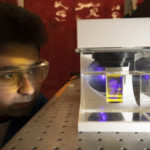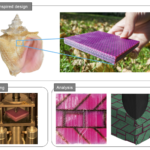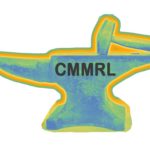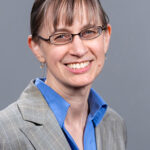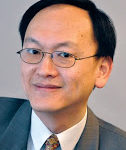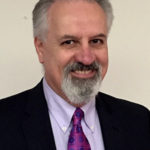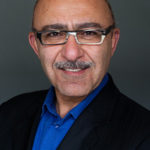Our research spans the invention, modeling and simulation of micro- and nano-scale manufacturing processes. We are particularly focused on processes that can be used to fabricate extremely rich and complex, multi-scale geometries, such as are found in semiconductor integrated circuits and biological tissues. Recent work includes the introduction of the tomographic volumetric additive manufacturing process, …
Research Interest
Gu Research Group
The Gu Research Group works at the intersection of mechanics, additive manufacturing, materials, and computer science. We aim to make additive manufacturing more accessible, economical, and ubiquitous. Using a bioinspired algorithmic-driven design approach, we harness tools such as advanced computational analysis, machine learning, and topology optimization to expand and revolutionize the field of smart additive manufacturing …
Computational Manufacturing and Materials Research Laboratory
Research themes: (1) Modeling and simulation of advanced manufacturing and 3D printing systems; (2) Modeling and simulation of multiphase/composite material behavior; (3) Modeling and simulation of fire propagation and control with the Fire Research Group; (4) Modeling and simulation of UAVs and swarms; (5) Modeling and simulation of biological systems; (6) Modeling and simulation of ballistic …
Tarek I. Zohdi
Will C. Hall Family Chair in Engineering
Associate Dean for Research, College of Engineering
Will C. Hall Endowed Chair
Chair of the UCB Computational & Data Science & Engineering Program
Professor of Mechanical Engineering
University of California, Berkeley
Berkeley, CA 94720-1740
zohdi@berkeley.edu
For more information see: ZOHDI-BIOGRAPHY
Professor Zohdi's CV
Research Group Website
Books and Publications
Associate Dean for Research, COE
Editor CMAME
Editor-in-Chief, Comp. Particle Mechanics
Chair, D.E. in Comp. and Data Science Eng. Program
Faculty Scientist, Lawrence Berkeley National Lab
Director, UC-DEWA
Director, Fire Research Group
Director, Next Generation Food Systems Center
Faculty Director, Masters of Advanced Studies-Engineering
Hayden Taylor
Vice Chair of Instruction
Associate Professor of Mechanical Engineering
University of California, Berkeley
Berkeley, CA 94720-1740
hkt@berkeley.edu
(510) 642-4901
For more information see: Design for Nanomanufacturing
Current Classes Taught
Hayden Taylor is an Associate Professor in the Department of Mechanical Engineering at the University of California, Berkeley. He was previously an Assistant Professor at Nanyang Technological University in Singapore, a Postdoctoral Research Fellow in the Biosystems and Micromechanics group at the Singapore-MIT Alliance for Research and Technology, and a Research Associate in the Microsystems Technology Laboratories at MIT.
Hayden was born in Bristol, United Kingdom, in 1981. He attended Bristol Grammar School and Trinity College, Cambridge, receiving the B.A. and M.Eng. degrees in Electrical and Electronic Engineering in 2004. He was sponsored as an undergraduate by ST Microelectronics. He is a Senior Scholar of Trinity College, Cambridge, and received the Cambridge University Engineering Department’s Baker Prize in 2004. Hayden received the Ph.D. in Electrical Engineering and Computer Science from MIT in 2009, working with Professor Duane Boning.
Hayden is a member of the IEEE, the Institution of Engineering and Technology, and the Institute of Physics. He was an Institution of Electrical Engineers Jubilee Scholar 2000-4, and was a Kennedy Scholar for the academic year 2004-5.
To view Professor Taylor’s CV, please click here.
Research Description:
The invention, modeling and simulation of micro- and nano-manufacturing processes, materials-testing techniques operating down to the nanoscale, and applications of polymeric materials in micro- and nano-fabrication—including for tissue scaffold engineering.
Key Publications:
To view a list of Professor Taylor’s publications, please visit the Design for Nanomanufacturing website.
Sara McMains
Professor of Mechanical Engineering
5145 Etcheverry HallUniversity of California, Berkeley
Berkeley, CA 94720-1740
mcmains@me.berkeley.edu
(510) 852-9359
For more information see: McMains Home Page
Current Classes Taught
Dr. McMains is a professor in the Department of Mechanical Engineering, University of California, Berkeley. Her research interests include Geometric DFM (Design for Manufacturing) feedback, geometric solid modeling, CAD/CAM, GPU algorithms, computer aided process planning, layered manufacturing, computer graphics, visualization, virtual prototyping, and virtual reality. Her current research focuses on new techniques for accessibility analysis and collision detection, with applications in haptic design environments, design for manufacturing for injection molding, design for cleanability, layered manufacturing, and machining.
McMains received her A.B. from Harvard University in Computer Science, and her M.S. and Ph.D. from UC Berkeley in Computer Science with a minor in Mechanical Engineering. She is the recipient of Best Paper Awards from Usenix (1995) and ASME DETC (2000), a Best Poster and a Best Paper Award from the ACM Solid and Physical Modeling Symposium (2007, 2008 — 2nd place), and the NSF CAREER Award (2005).
Research Description:
Geometric and solid modeling, computer aided design, computer aided manufacturing, layered manufacturing, computer graphics and visualization, virtual prototyping, virtual reality.
Liwei Lin
James Marshall Wells Academic Chair in Mechanical Engineering
Distinguished Professor of Mechanical Engineering
James Marshall Wells Academic Chair
Co-Director, Berkeley Sensor & Actuator Center
University of California, Berkeley
Berkeley, CA 94720-1740
lwlin@berkeley.edu
(510) 643-5495
For more information see: Lin Lab
Lin Home Page
Current Classes Taught
2006 – 2009 Vice Chair – Graduate Study, Mechanical Engineering Department, University of California at Berkeley
2004 Professor, Mechanical Engineering Department, University of California at Berkeley
2001 Associate Professor, Mechanical Engineering Department, University of California at Berkeley
1999 Assistant Professor, Mechanical Engineering Department, University of California at Berkeley
1996 Assistant Professor, Mechanical Engineering Department, University of Michigan
1994 Associate Professor, Institute of Applied Mechanics, National Taiwan University
1993 Senior Research Scientist, BEI Electronics Inc.
1993 PhD, Mechanical Engineering, University of California at Berkeley
1991 MS, Mechanical Engineering, University of California at Berkeley
1986 BS, Power Mechanical Engineering, National Tsing Hua University
Research Description:
MEMS (Microelectromechanical Systems); NEMS (Nanoelectromechanical Systems); Nanotechnology; design and manufacturing of microsensors and microactuators; development of micromachining processes by silicon surface/bulk micromachining; micromolding process; mechanical issues in MEMS including heat transfer, solid/fluid mechanics, and dynamics.
Key Publications:
For a list of Professor Lin’s publications, please click here.
Kyriakos Komvopoulos
Distinguished Professor of Mechanical Engineering
5143 Etcheverry HallUniversity of California, Berkeley
Berkeley, CA 94720-1740
kyriakos@me.berkeley.edu
(510) 642-2563
For more information see: Current Classes Taught
Research Description:
Theoretical and numerical studies in nano/microscale contact mechanics, tribology, mechanical behavior of thin-film structures, deposition and characterization of ultrathin films by sputtering and filtered cathodic vacuum arc methods, stress analysis, fracture, and adhesion of dynamic microdevices, plasma-assisted surface modification of biopolymers, surface chemical functionalization for enhanced biocompatibility and cell activity, mechanotransduction effects at the single-cell and tissue levels, and electrospun fibrous scaffolds for tissue engineering.
To learn more about Professor Komvopoulos’ research, please click here.
To view a list of Professor Komvopoulos’ supervised current and past graduate students and visiting scholars, please click here.
To view a biographical sketch of Professor Komvopoulos, please click here.
To view the content of courses taught by Professor Komvopoulos, please click here.
Key Publications:
To view a list of Professor Komvopoulos’ publications, please click here.
Homayoon Kazerooni
Professor of Mechanical Engineering
6147 Etcheverry HallUniversity of California, Berkeley
Berkeley, CA 94720-1740
kazerooni@berkeley.edu
(510) 642-2964
For more information see: Berkeley Robotics & Human Engineering Laboratory
Current Classes Taught
Dr. Kazerooni is a professor of Mechanical Engineering at the University of California, Berkeley, where he also serves as the director of the Berkeley Robotics and Human Engineering Laboratory. With more than 30 years of mechanical engineering experience and a doctorate degree from MIT, he is a leading expert in robotics, control sciences, exoskeletons, medical devices, human-machine systems and augmentation, bioengineering, mechatronics design, and intelligent assist devices. Prior to his more well-known research on lower extremity exoskeletons, Dr. Kazerooni led his team at Berkeley to successfully develop robotics systems that enhanced human upper extremity strength. The results of this work led to a new class of Intelligent Assist Devices (IAD) that are currently marketed worldwide by leading material handling corporations for use by manual laborers in distribution centers and factories globally.
Dr. Kazerooni’s later work focuses on the control of human-machine systems specific to lower human extremities. After developing BLEEX, ExoHiker, and ExoClimber–three load-carrying exoskeletons–his team at Berkeley created HULC (Human Universal Load Carrier). It is the first energetically-autonomous, orthotic, lower extremity exoskeleton that allows its user to carry 200-pound weights in various terrains for an extended period, without becoming physically overwhelmed. The technology was licensed to Lockheed Martin. Dr. Kazerooni has also developed lower-extremity technology to aid persons who have experienced a stroke, spinal cord injuries, or health conditions that obligate them to use a wheelchair. His medical exoskeletons, Ekso and Phoenix have successfully allowed those who have been paralyzed to walk, stand, and speak face to face with peers in an upright position. The technologies related to Ekso and Phoenix are licensed to Ekso Bionics and suitX.
In addition to his teaching work and research experience in academia, Dr. Kazerooni is also an entrepreneur. In 2005, he founded Ekso Bionics (eksobionics.com), which went on to become a publicly-owned company in 2014 and now supplies medical exoskeleton (Ekso) to a great number of rehabilitation centers worldwide. Later he founded suitX (suitx.com), a VC, industry, and government funded company that provides industrial and medical exoskeletons. suitX was acquired by Ottobock, the largest European medical device company in late 2021.
Dr. Kazerooni has won numerous awards including Discover Magazine’s Technological Innovation Award, the McKnight-Land Grant Professorship, and has been a recipient of the outstanding ASME Investigator Award. His research was recognized as the most innovative technology of the year in New York Times Magazine. He has served in a variety of leadership roles in the mechanical engineering community and was notably the editor of two journals: ASME Journal of Dynamics Systems and Control and IEEE Transaction on Mechatronics. A recognized authority on robotics, Dr. Kazerooni has published more than 200 articles to date, delivered over 130 plenary lectures internationally, and is the inventors of over 200 patents.
Research Description:
Bioengineering, robotics, control systems, mechatronics, design, automated manufacturing and human-machine systems
Key Publications:
To view a list of Professor Kazerooni’s publications, please visit the Berkeley Robotics & Human Engineering Laboratory’s website.
Grace X. Gu
Assistant Professor of Mechanical Engineering
6177 Etcheverry HallUniversity of California, Berkeley
Berkeley, CA 94720-1740
ggu@berkeley.edu
(510) 643-4996
For more information see: Gu Research Group
Current Classes Taught
Education:
PhD Mechanical Engineering, MIT, 2018
MS Mechanical Engineering, MIT, 2014
BS Mechanical Engineering, University of Michigan, 2012
Research Description:
Research interests: Composites, additive manufacturing, fracture mechanics, topology optimization, machine learning, finite element analysis, and bioinspired materials.
Key Publications:
S Lee, Z Zhang, and GX Gu. Deep learning accelerated design of mechanically efficient architected materials, ACS Applied Materials & Interfaces, 2023
B Zheng, Z Jin, G Hu, J Gu, SY Yu, JH Lee, and GX Gu. Machine learning and experiments: A synergy for the development of functional materials, MRS Bulletin, 2023
S Lee, D Lim, E Pegg, and GX Gu. The origin of high-velocity impact response and damage mechanisms for bioinspired composites, Cell Reports Physical Science, 2022
JH Lee, Z Zhang, and GX Gu. Maximum electro-momentum coupling in piezoelectric metamaterial scatterers, Journal of Applied Physics, 2022
Z Zhang, Z Jin, and GX Gu. Efficient pneumatic actuation modeling using hybrid physics-based and data-driven framework, Cell Reports Physical Science, 2022
S Lee, Z Zhang, and GX Gu. Generative machine learning algorithm for lattice structures with superior mechanical properties, Materials Horizons, 2022
Z Jin, Z Zhang, K Demir, and GX Gu. Machine learning for advanced additive manufacturing, Matter, 2020
B Zheng and GX Gu. Machine learning-based detection of graphene defects with atomic precision, Nano-Micro Letters, 2020
C Yang, Y Kim, S Ryu, and GX Gu. Prediction of composite microstructure stress-strain curves using convolutional neural networks, Materials & Design, 2020
Z Zhang, K Demir, and GX Gu. Developments in 4D-printing: A review on current smart materials, technologies, and applications, International Journal of Smart and Nano Materials, 2019
To view a complete list of Professor Gu’s publications, please visit the Gu Research Group website.
David M. Auslander
Professor of the Graduate School
Professor of the Graduate School
5120 Etcheverry HallUniversity of California, Berkeley
Berkeley, CA 94720-1740
dma@me.berkeley.edu
(510) 642-4930
For more information see: Current Classes Taught
Research Description:
Automatic control system design, mini-microcomputer system bioengineering, modeling and simulation of dynamic systems, process control.


